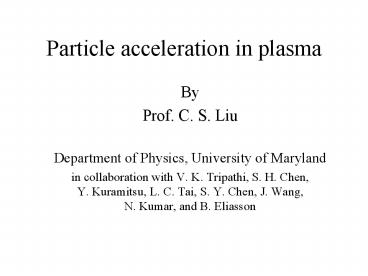Particle acceleration in plasma - PowerPoint PPT Presentation
1 / 39
Title:
Particle acceleration in plasma
Description:
Particle acceleration in plasma By Prof. C. S. Liu Department of Physics, University of Maryland in collaboration with V. K. Tripathi, S. H. Chen, – PowerPoint PPT presentation
Number of Views:239
Avg rating:3.0/5.0
Title: Particle acceleration in plasma
1
Particle acceleration in plasma
- By
- Prof. C. S. Liu
- Department of Physics, University of Maryland
- in collaboration with V. K. Tripathi, S. H. Chen,
Y. Kuramitsu, L. C. Tai, S. Y. Chen, J. Wang,
N. Kumar, and B. Eliasson
2
Cosmic ray acceleration
3
(No Transcript)
4
Magnetosphere of the Earth
5
The Earths magnetic field and magnetosphere
6
Cavity flow with reentrant jet
7
Mono-energetic electrons on the Earth
8
Electron can be accelerated by plasma wave
Acceleration gradient of plasma wave can be large
Maximum acceleration gradient limited by the wave
breaking
Non-relativistic wave-breaking amplitude
or
giving,
, for
SLAC on a slab !!!
Relativistic wave-breaking amplitude
is the Lorentz factor for plasma wave
9
How to generate plasma wave ??
- Mode conversion
- Beat wave excitation with two laser pulses
- Raman scattering
- Relativistic wake plasma wave excitation by
electron beam or short pulse laser
10
1) Mode conversion
An EM wave obliquely propagates into a plasma
with density gradient.
An oscillatory current can cause space charge
oscillations. EM wave ? ES wave
11
2) Beat wave excitation
- Two long laser pulses
- Plasma wave excitation possible if,
- Maximum saturated amplitude of the plasma wave
due to relativistic mass effect
Backscattering,
Forward scattering,
(Rosenbluth and Liu, PRL, 1972)
12
Nonlinear frequency-amplitude relation
13
3) Raman Scattering by Plasma Wave
Laser light
Plasma
Scattered light
Feed back
Instability
Current
Growth rate
14
Raman heated electrons
15
Raman scattering causes electron acceleration
16
4) Relativistic wake plasma wave excitation by
electron beam or short pulse laser
Maximum electric field of the plasma wave
17
Acceleration of a SLAC electron beam
Demonstration of acceleration in beam driven
wakefield (SLAC)
Hogan et.al. Phys. Rev. Lett. 95, 054802 (2005)
18
Mono-energetic electron beam by short pulse laser
Observation of mono-energetic beam of electrons
with energy 50-170 MeV by three groups.
Mangles et.al, Nature, 431, 535 (2004), Faure
et.al., Nature, 431, 541 (2004), Geddes et.al.,
Nature, 431, 538 (2004)
19
First direct measurement of acceleration
gradient eE2.5 GeV/m 103 of linac.
Chen, et.al.(Particle accelerator group, Academia
Sinica, NCU)
20
Laser wakefield acceleration and ion channel
formation in laser
Micro magnetosphere
Relativistic self focusing
where
Laser power,
Relativistic dielectric constant
Relativistic effect increases
Ponderomotive effect decreases
Resultant effect ion channel formation
21
Electron trajectories
22
Number density of electrons on axis
23
Wake field on axis
24
Injection and acceleration of mono-energetic
electrons by a self-modulated laser pulse
- Experiments at Academia Sinica (PRL, 2006)
- OOPIC (object-oriented particle-in-cell) code
- two spatial and three velocity components
- pre-ionized electron-proton plasma
- linearly polarized Gaussian laser pulse
- s-polarization (normal to the density
perturbation) - moving window
- immobile ions
- Parameters
- Peak laser intensity I0 8x1018 W/cm2 (a0
2.) - Laser wavelength l 0.81 mm
- Pulse duration t 45 fs
- Gas density n 4x1019/cm3 (wp/wL 0.15)
- Initial waist size w0 4 mm
- Chirp bandwidth 27 nm
25
Initial Plasma Density
26
Time 0.735ps
27
Time 0.829 ps
28
Time 1 ps
29
Time 1.1 ps
50 MeV mono energetic electron beam
30
The wake field bunches the electrons in real
space.
Time 1.1 ps
31
The modulated laser field traps electrons and
push electrons moving with the laser pulse.
Time 1.1 ps
32
The modulated laser field traps electrons and
push electrons moving with the laser pulse. (The
plasma is turned off at time 1.33 ps)
Time 1.43 ps
50 MeV mono energetic electron beam
Ez of laser pulse
33
Distribution function
34
px - x phase space
35
Weibel instability
Growth rate
36
Thank you
37
Outline
- Plasma universe
- Plasma wave excitation and trapping of resonant
electrons - Laser driven acceleration and production of the
mono-energetic electrons beam - Ion acceleration
- Concluding remark
38
Plasma universe
Plasma dominated universe
Three minutes after Big Bang -----
Radio jets, X-ray sources, g-ray bursts, pulsar,
accretion disk etc.
We observe our universe mostly by EM waves. Its
dispersion relation,
39
Ion bubble formation by different a































